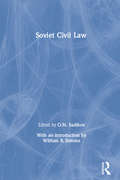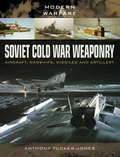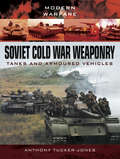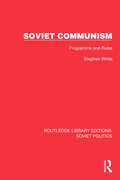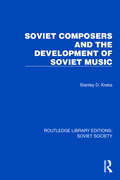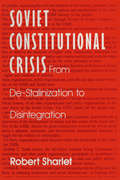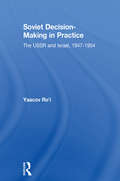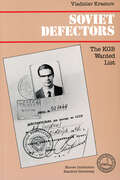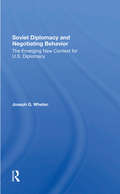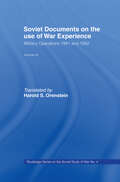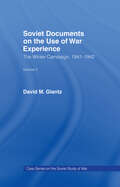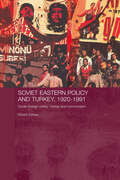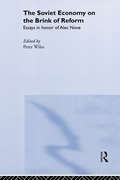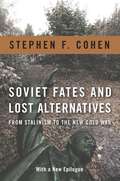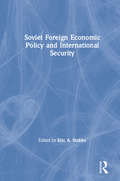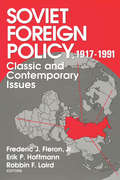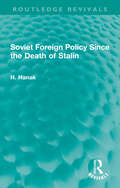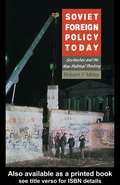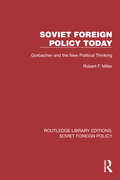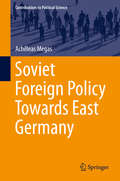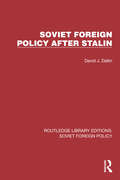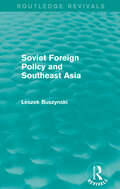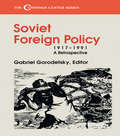- Table View
- List View
Soviet Civil Law
by O.N. SadikovThis volume is an unabridged translation of the textbook ‘Soviet Civil Law’, originally published in 1983 under the auspices of the USSR Ministry of Justice. Edited by Professor O.N. Sadikov, the work includes contributions from nine Soviet legal scholars
Soviet Cold War Weaponry: Aircraft, Warships And Missiles (Modern Warfare)
by Anthony Tucker-Jones"In this companion volume to his photographic history of Soviet tanks and armoured vehicles, Anthony Tucker-Jones provides a visual guide to the vast array of aircraft, warships and missiles the Soviet armed forces deployed at the height of the Cold War. Although the superpowers never came to blows, the so-called 'Cold War' was far from cold, with numerous 'hot' proxy wars being fought in Africa and the Middle East. All these conflicts employed Soviet weaponry which has been captured in action in the colour and black-and-white photographs selected for this book. Between the 1950s and 1980s Soviet and Warsaw Pact countries churned out thousands of weapons ready for the Third World War. They also embarked on a technological arms race with NATO in an attempt to counter each new piece of equipment as it appeared. The MiG fighters, the Badger and Backfire bombers, the nuclear submarines have achieved almost iconic status, but, as Anthony Tucker-Jones's book shows, there was much more to the Soviet armoury than these famous weapons. Much of it, despite its age, remains in service with armies, guerrilla forces and terrorist organizations around the world today."
Soviet Cold War Weaponry: Tanks and Armoured Vehicles (Modern Warfare)
by Anthony Tucker-JonesThe T-54, T-62 and T-72 main battle tanks along with the personnel carriers, assault guns, self-propelled guns and anti-tank missiles that are illustrated in this photographic history represent the high point in the design and manufacture of armoured vehicles by the Soviet Union during the Cold War. Although the superpowers never came to blows, the 'Cold War' was far from cold, as numerous 'hot' proxy wars were fought in Africa and the Middle East, and these conflicts employed the Soviet weaponry that is shown in action in the colour and black-and-white photographs selected for this book.Between the 1950s and 1980s Soviet and Warsaw Pact countries produced thousands of tanks and armoured vehicles ready for the Third World War. They embarked on a technological arms race with the NATO allies in an attempt to counter each new piece of equipment as it appeared in service. Much of this Soviet weaponry has achieved almost iconic status and, despite its age, remains in service with armies, guerrilla forces and terrorist organizations around the world today. It is also of enduring interest to collectors, re-enactors and modellers who are fascinated by the military equipment of the late twentieth century.
Soviet Communism: Programme and Rules (Routledge Library Editions: Soviet Politics)
by Stephen WhiteSoviet Communism (1989) contains the full text of the 1986 new and significantly revised foundational documents of Soviet Communism, the Programme and Party Rules – changes agreed following Mikhail Gorbachev’s call for the radical and democratic reform of the Party and of the Soviet political system as a whole.
Soviet Composers and the Development of Soviet Music (Routledge Library Editions: Soviet Society)
by Stanley Dale KrebsSoviet Composers and the Development of Soviet Music (1970) is a thought-provoking review of Soviet music and musicians. This scholarly and readable distillation of factual information and well-reasoned conclusions is the result of many years of exhaustive study of reference works, monographs and journals, as well as musical scores both published and unpublished, all supplemented by interviews and personal participation in Soviet musical life. The author presents a cogent, critical analysis of the relationship between extra-musical pressures and the theory and practice of artistic autonomy. The lives and works of some two dozen major Soviet composers are discussed, and insight is provided into Soviet thinking about music, and thinking about the arts.
Soviet Constitutional Crisis (Contemporary Soviet - Post-soviet Politics Ser.)
by Robert SharletMoving from the adoption of the "post-Stalin" Constitution of 1977 through its subsequent implementation under Brezhnev, Andropov, and Chernenko to the radical legal "restructuring" of the Gorbachev years, Robert Sharlet traces the gradual evolution of a nascent constitutionalism in the erstwhile USSR. Sharlet, a noted authority on Soviet law and constitutional development, demonstrates the gradual transformation of law from an instrument of Communist Party rule into the new "rules of the game" for nonauthoritarian political development. In effect, he argues, one of Gorbachev's most durable achievements may be his redefinition of Soviet politics into a legal idiom along with his relocation of policymaking from behind the closed doors of Party conclaves into the more open, emergent arena of constitutional government. In analyzing the politics of law from the Brezhnev era to the rise of Yeltsin, the author takes account of the "war of laws", the symbolic uses of the Soviet constitution, and even the fact that the leaders of the failed coup attempted to justify their seizure of power on constitutional grounds. Constitutionalism has sufficiently suffused Soviet public life, the book concludes, that most of the sovereign republics as successors to the former USSR, have begun designing their futures - to varying degrees - in constitutional forms.
Soviet Decision-Making in Practice: The USSR and Israel, 1947-1954
by Yaacov Ro'iThe Soviet Union executed an apparent about-face in its traditional anti-Zionist position when the Palestine issue came before the United Nations in 1947. In addition to political support at the UN from May 1947 to May 1949, important military assistance was rendered to the Jewish Palestinian Yishuv throughout 1948 by the Eastern bloc. Toward the end of that year, however, indications of change became apparent, and the Soviet Union began criticizing Israel.This book studies the USSR's attitude toward the establishment of a Jewish state in Palestine in the immediate post-World War II period and toward Israel in the first years of its existence, and it investigates the complex of considerations that caused the initial apparent reversal of traditional Soviet anti-Zionism. The author contends that this support for Israel contributed considerably to the evoking of Soviet Jewry's enthusiastic reaction to the establishment of the State. But this very reaction resulted in turn in Moscow changing its tactics again, since it could not allow its Jewish citizens to identify with a state outside the Soviet Union and the Communist orbit.During the few years after the Israeli War for Independence, in which the Arab-Israeli conflict was relatively low key, the USSR adopted a position of seeming neutrality between two sides—while quietly wooing the Arab nations. Ro'i examines how toward the end of the Stalin period the Jewish problem again intervened with the infamous' 'Doctor's Plot," and how early in 1953 the Soviet Union severed diplomatic relations with Israel. One year later the USSR cast its first two pro-Arab vetoes in the UN Security Council, and from this point on Soviet-Israeli relations openly became a function of the increasingly cordial Soviet friendship with the Arab world.
Soviet Defectors: The KGB Wanted List
by Vladislav KrasnovThe topic of defection is taboo in the USSR, and the Soviets, are anxious to silence, downplay, or distort every case of defection. Surprisingly, Vladislav Krasnov reports, the free world has often played along with these Soviet efforts by treating defection primarily as a secretive matter best left to bureaucrats. As a result, defectors' human rights have sometimes been violated, and U.S. national security interests have been poorly served.
Soviet Diplomacy And Negotiating Behavior: The Emerging New Context For U.s. Diplomacy
by Joseph G. Whelan"The foreign affairs book of the season ... an absorbing review of the nitty-gritty of Soviet-American diplomacy over the years."—Stephen S. Rosenfeld, The Washington Post "Vast in its historical sweep. . . . Focusing on the period since the Bolshevik Revolution, Whelan stresses five themes: the nature of negotiating behavior, its principal characteristics, elements contributing to its formation, aspects of continuity and change during more than 60 years, and the implications of the record for U.S. foreign policy in the 1980s. "The bulk of the book traces Soviet diplomacy under Chicherin and Litvinov, the enormously complex and detailed wartime conferences with Stalin, the descent into the cold war, the transition to peaceful coexistence with Nikita Krushchev (including fascinating details on the Cuban Missile Crisis), peaceful coexistence with Leonid Brezhnev (including extensive chronological analysis of the SALT process) and finally, judgements about how U.S. policy should be informed in future un- dertakings with the Soviets."—Nish Jamgotch, Jr., The American Political Science Review
Soviet Documents on the Use of War Experience: Volume Three: Military Operations 1941 and 1942 (Soviet (Russian) Study of War)
by Harold S. Orenstein David M. GlantzThe Soviet Study of War" series examines the lessons Soviet military theorists and commanders learned from the study of their own military experience. These are translations of Soviet documents.
Soviet Documents on the Use of War Experience: Volume Two: The Winter Campaign, 1941-1942 (Soviet (Russian) Study of War)
by Harold S. OrensteinThe Soviet Study of War" series examines the lessons Soviet military theorists and commanders learned from the study of their own military experience. These are translations of Soviet documents.
Soviet Eastern Policy and Turkey, 1920-1991: Soviet Foreign Policy, Turkey and Communism (Routledge Studies in the History of Russia and Eastern Europe)
by Bulent GokayThis is an impressive work that traces the relationship between the Soviet Union and Turkey on the one hand, and the Soviet Union and the Turkish Communist Party on the other, from the consolidation of the communist regime in Moscow until its fall. The book considers how 'Soviet Eastern Policy' was formed, how it changed over time, what the Soviet leaders hoped to gain in Turkey, and what impact Soviet policy had on the development of the Turkish communist movement. It is a valuable resource for students and scholars with an interest in Russian and Soviet poltics and international relations.
Soviet Economy Brink Of Reform
by P.J.D. WilesFirst Published in 1988. Routledge is an imprint of Taylor & Francis, an informa company.
Soviet Emigre Artists
by Marilyn RueschemeyerThe blind mendicant in Ukrainian folk tradition is a little-known social order, but an important one. The singers of Ukrainian epics, these minstrels were organized into professional guilds that set standards for training and performance. Repressed during the Stalin era, this is their story.
Soviet Fates and Lost Alternatives: From Stalinism to the New Cold War
by Stephen CohenIn this wide-ranging and acclaimed book, Stephen F. Cohen challenges conventional wisdom about the course of Soviet and post-Soviet history. Reexamining leaders from Nikolai Bukharin, Stalin's preeminent opponent, and Nikita Khrushchev to Mikhail Gorbachev and his rival Yegor Ligachev, Cohen shows that their defeated policies were viable alternatives and that their tragic personal fates shaped the Soviet Union and Russia today. Cohen's ramifying arguments include that Stalinism was not the predetermined outcome of the Communist Revolution; that the Soviet Union was reformable and its breakup avoidable; and that the opportunity for a real post-Cold War relationship with Russia was squandered in Washington, not in Moscow. This is revisionist history at its best, compelling readers to rethink fateful events of the twentieth and early twenty-first centuries and the possibilities ahead.In his new epilogue, Cohen expands his analysis of U.S. policy toward post-Soviet Russia, tracing its development in the Clinton and Obama administrations and pointing to its initiation of a "new Cold War" that, he implies, has led to a fateful confrontation over Ukraine.
Soviet Foreign Economic Policy and International Security
by Eric StubbsMore than half a decade has passed since Gorbachev launched his "prerestroika" programme to reform the Soviet Union, but the struggle between reformers and conservatives continues to rage while the final outcome, and even the goals of the programme, remains a mystery. Whatever the outcome of this transformation, its impact will reverberate well beyond the borders of the USSR to shape US security and commercial policies into the next century. This edited volume brings together original essays by US-Soviet relations scholars and international business and security experts to explore the many complex and critical issues that the United States must confront in developing its commercial and security policies for the next decade.
Soviet Foreign Policy 1917-1991: Classic and Contemporary Issues
by Frederic J. Fleron Erik P. Hoffmann Robbin F. LairdThe purpose of this anthology is to deepen Western understanding of the sources and substance of the foreign policy of the Soviet Union. Authoritative analysts here explore significant issues in Soviet foreign relations from the era of the Bolshevik Revolution and the Civil War to the period of reform that preceded the final collapse of the Soviet system. The volume is designed for courses in Soviet political history, diplomatic history, comparative foreign policy, and the mainstream of international relations.
Soviet Foreign Policy Since the Death of Stalin (Routledge Revivals)
by H. HanakOriginally published in 1972, this volume contains selected significant documents to illustrate Soviet foreign policy between 1953 and 1970, according to its author, 'in the words of Soviet leaders and Soviet people.' Extracts from speeches by Khrushchev, Mikoyan, Brezhnev and Kosygin are included, together with commentary from other communist leaders, including Hoxha of Albania and Nagy of Hungary. The invasion of the former Czechoslovakia and the Chinese view of Soviet foreign policy are fully covered. A comprehensive and informative introduction traces the course of Soviet foreign policy since 1953. Some general considerations are given in the conclusion, and short explanatory comments elucidate the documents themselves.
Soviet Foreign Policy Today: Gorbachev And The New Political Thinking
by Robert F. MillerThis textbook examines Soviet thinking in the economic, political and military spheres, linking domestic and foreign policies. Part One describes the evolution of its foreign policy; Part Two, details the impact it had on the rest of the world (by region).
Soviet Foreign Policy Today: Gorbachev and the New Political Thinking (Routledge Library Editions: Soviet Foreign Policy #14)
by Robert F. MillerSoviet Foreign Policy Today (1991) is the culmination of almost 30 years of observations of Soviet foreign and domestic politics, written at the time of Gorbachev’s great changes. It locates the changes of Gorbachev in the context of the traditional goals and practices of Soviet foreign policy, and it does not shy away from presenting seemingly controversial interpretations of the USSR’s international politics.
Soviet Foreign Policy Towards East Germany
by Achilleas MegasThis book examines Soviet Foreign Policy towards East Germany in the late 1980s. By focusing on the complex interaction between domestic political thought and developments in the international system, the author illustrates the hierarchical relationship between the GDR and the USSR and offers different perspectives for understanding Soviet foreign policy. The books demonstrates that shifts in Soviet policy towards the GDR stemmed, on the one hand, from the international level, in that Soviet security was legitimated by the existence of two full-fledged German states, and, on the other, may be best explained in terms of ideas and Gorbachev's new political philosophy.
Soviet Foreign Policy after Stalin (Routledge Library Editions: Soviet Foreign Policy #13)
by David J. DallinSoviet Foreign Policy After Stalin, first published in 1962, reviews the constants and variables in the Soviet international course after Stalin. It examines the legacy of Stalin’s policy of Soviet imperialism, and how much his foreign policy was followed by his successors. It looks at the period of transition, the uprisings in Europe, the new Soviet course toward the ‘uncommitted nations’, Sino-Soviet relations, the ascent of Khrushchev and the stiffening of the Soviet view toward the West.
Soviet Foreign Policy and Southeast Asia: Soviet Foreign Policy And Southeast Asia (Routledge Revivals)
by Leszek BuszynskiThis book focuses on the activity of the Soviet Union in Southeast Asia and the effects of Soviet policy on the region from 1969 to the time of first publication in 1986. In particular, Leszek Buszynski examines the rivalry between the Soviet Union and China, Soviet presence in Vietnam, and the responsive efforts of surrounding regions towards collective security. U.S. policy in the region is a key consideration, particularly in terms of American attempts to placate China and encourage Japan to assist in the defence of the region. With a concluding assessment of regional trends and possible outcomes, this is an important and valuable work for students and scholars with an interest in the history and politics of international diplomacy in Southeast Asia.
Soviet Foreign Policy, 1917-1941
by George F. KennanThe purpose of this treatise is to give a brief account of Soviet foreign policy from the moment of the Bolshevik seizure of power in 1917 to the involvement of the Soviet Union in the Second World War, in June, 1941.
Soviet Foreign Policy, 1917-1991: A Retrospective (Cummings Center Series)
by Gabriel GorodetskyA comprehensive assessment of Soviet relations with the West, set in the context of the emergence of a new Russia. This volume anlayzes the formulation of foreign policy during the period from the first decade of the Bolshevik Revolution, through the gradual erosion of ideological differences.
